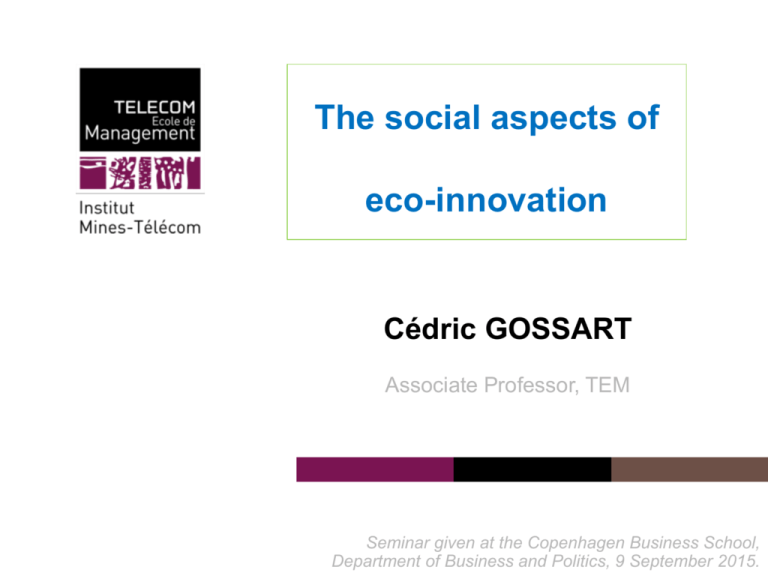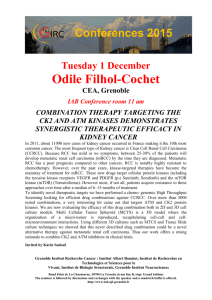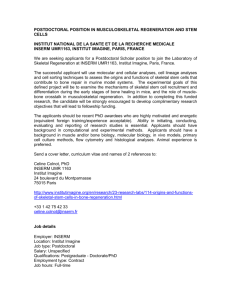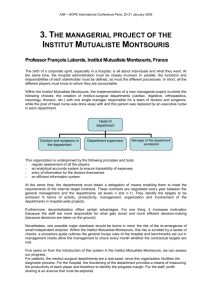Institut Mines-Télécom
advertisement

The social aspects of eco-innovation Cédric GOSSART Associate Professor, TEM Institut Mines-Télécom Seminar given at the Copenhagen Business School, Department of Business and Politics, 9 September 2015. Cédric GOSSART • PhD from U. of Sussex (SPRU), 2004 • Current position: Associate Professor in TEM since 2007 • Now working on ICT & environment • Networks: RT8 (IMT), ÉcoInfo (CNRS) More details: • http://gossart.wp.mines-telecom.fr page 2 Institut Mines-Télécom Télécom École de Management Institut Mines-Télécom http://www.mines-telecom.fr/ 3 Institut Mines-Télécom Télécom École de Management 26 engineering & business schools IMT: Key figures 12,555 students 2,000 researchers 1,725 PhD students +4000 graduates per year 4, 800 staff members 2 Carnot Institutes Including over 2,500 engineers 8% engineering degrees issued in France €121 M research-generated income per year 32 % foreign students 38 % grant holders 4 Institut Mines-Télécom About 100 business start-ups per year at the schools’ incubators Télécom École de Management This presentation I. What is eco-innovation? • Definitions • Case studies II. The social aspects of eco-innovation 5 • Definition • The case of lighting transition 09/09/2015 Institut Mines-Télécom Télécom École de Management • Definitions (references in JEE paper) Kemp and Oltra (2011: 249): 3 categories of env. impacts: Eco-innovations are “innovations whose environmental impact on a life cycle basis is lower than those of relevant alternatives”. 1) Pollutions 2) Exhaustion of nat. resources 3) Global env. changes Source: Cecere, G., N. Corrocher, et al. (2014). Lock-in and path dependence: An evolutionary approach to eco-innovations. Journal of Evolutionary Economics 24(5): 1037-1065. 6 09/09/2015 Institut Mines-Télécom Télécom École de Management • Definitions (references in JEE paper) Taylor et al. (2005: 698): eco-innovations safeguard public goods, which are not necessarily protected by standard innovations: “‘Environmental technology’ refers to everything from ‘end-of-pipe’ pollution control technologies to alternative energy technologies that share the characteristic of helping to maintain the ‘public good’ of a clean environment.” Source: Cecere, G., N. Corrocher, et al. (2014). Lock-in and path dependence: An evolutionary approach to eco-innovations. Journal of Evolutionary Economics 24(5): 1037-1065. 7 09/09/2015 Institut Mines-Télécom Télécom École de Management I. What is eco-innovation? • Definitions (references in JEE paper) Rennings (2013: 333): eco-innovations (EI) can be a byproduct of other innovations: “Environmental innovations consist of new or modified processes, techniques, practices, systems and products to avoid or to reduce environmental harms. Environmental innovations may be developed with or without the explicit aim of reducing environmental harm.” Source: Cecere, G., N. Corrocher, et al. (2014). Lock-in and path dependence: An evolutionary approach to eco-innovations. Journal of Evolutionary Economics 24(5): 1037-1065. 8 09/09/2015 Institut Mines-Télécom Télécom École de Management • Definitions (references in JEE paper) European Commission (2011): “Eco-innovation is any form of innovation resulting in or aiming at significant and demonstrable progress towards the goal of sustainable development, through reducing impacts on the environment, enhancing resilience to environmental pressures, or achieving a more efficient and responsible use of natural resources” NB: Other definitions are listed in the Table A1 of the JEE paper (in appendix). Source: Cecere, G., N. Corrocher, et al. (2014). Lock-in and path dependence: An evolutionary approach to eco-innovations. Journal of Evolutionary Economics 24(5): 1037-1065. 9 09/09/2015 Institut Mines-Télécom Télécom École de Management • Case studies: What do they tell us about EI? Commonalities between eco-innovations and standard innovations Require similar resources to be developed & adopted (knowledge, capabilities, coordination and attention). Development intentional/unintentional. Various forms: production equipment, methods and procedures, product designs, product delivery mechanisms, new or modified processes, practices, systems and products. Can result from organisational changes (transform organisational processes, e.g. recycling schemes, EMAS). 10 09/09/2015 Institut Mines-Télécom Télécom École de Management • Case studies Differences between eco-innovations and standard innovations Eco-innovations have to meet, intentionally or not, specific environmental goals. The development of eco-innovations depends upon the degree of environmental knowledge and sensibility towards green issues on producers’ and consumers’ sides. Eco-innovation claims hard to verify (best = LCA), except if they follow strict guidelines, norms, labels or standards. 11 09/09/2015 Institut Mines-Télécom Télécom École de Management • Case studies Shouldn’t all innovations be eco-innovations? Why do eco-innovations fail? Because of social events. Brian Arthur (1989): increasing returns to adoption. Small historical accidents can provide a given technology an initial advantage over competitors that can create path dependence. Cf. Qwerty. Lock-in may also derive from individuals’ characteristics, attitudes and behaviours (Rogers 1995). 12 09/09/2015 Institut Mines-Télécom Télécom École de Management • Case studies What social aspects cause the lock-in of eco-innovations? Continuous improvements in a given technology further strengthens their market. For example, the internal combustion engine (ICE) was environmentally improved by efficiency inventions such as direct fuel injection, particle filters, and new combustion concepts (Oltra and Saint Jean 2009). => strong and persistent dominant design (most engine innovations still focused on incremental changes within this design + on the consumer side: demand for incremental changes). 13 09/09/2015 Institut Mines-Télécom Télécom École de Management • Case studies Example of power plants (lock-in due to incremental changes) Since 1980: Coal-fired power plants dominate, no radical innovation succeeded (Rennings et al. 2013). Only changes: technological components (e.g. scrubbing technologies to remove sulphur and nitrogen oxides), no fundamental changes in existing plants to avoid harming productivity. => energy efficiency of German power plants gradually improved by combining established gas and steam cycles => lock-in carbon-based plants. => old technologies could keep up with newer and more efficient ones (locked in technological niches) => reinforcement of barriers to paradigm shifts. 14 09/09/2015 Institut Mines-Télécom Télécom École de Management • Case studies Example of cars (lock-in due to incremental changes) Social aspects of lock-in => domination of incremental innovations: lack of new infrastructure and capital required for more radical technological changes + sunk costs (Costantini and Mazzanti 2012). => emergence of 2 main trajectories (Dijk et al. 2011): • Improvement of vehicles powered by ICE; • Slow diffusion of electricity-powered vehicles. 15 09/09/2015 Institut Mines-Télécom Télécom École de Management • Case studies Other sources of lock-in: Cost-related factors Increasing returns to scale keep costs down, and an existing technology such as the internal combustion engine limits high sunk costs related with the development a new fuel infrastructure. The importance of the financial commitment required to ecoinnovate is often mentioned as a barrier to implement environmental programmes (Noci and Verganti 1999), but it is particularly the case for SMEs (del Brıo ́ and Junquera 2002; Zutshi and Sohal 2004). E.g. LEDs. 16 09/09/2015 Institut Mines-Télécom Télécom École de Management • Case studies Technological niches and complexity as sources of lock-in The fact that the success of technological niches is highly uncertain deters firms to adopt the technologies nested in those niches. For example, eco-innovations such as the ones relying on integrated gasification combined cycles or on pressurised pulverised coal combustion hardly made it out of pilot plants or technology niches such as the refining industry. The regime in place could not reduce the market uncertainties deterring investment in new technologies, and the existing pollution-intensive technological paradigm remained dominant (Rennings et al. 2013). 17 09/09/2015 Institut Mines-Télécom Télécom École de Management • Case studies Technological niches and complexity as sources of lock-in In the case of power plants, it was the lack of radical alternatives which further strengthened the existing pollution-intensive trajectory. Radical alternative eco-innovations were too weak to enter and change the dominant trajectory, and this very weakness enabled the further strengthening of the more polluting technological regime. 18 09/09/2015 Institut Mines-Télécom Télécom École de Management • Case studies Stakeholders can deter eco-innovations Regulation can strengthen an existing, and possibly inefficient trajectory, by promoting incremental improvements within this trajectory. Ex. Swiss bioenergy sector: energy policies (electricity feed-in schemes) stimulated investments in wood-to-energy technologies => lock-in to environmentally suboptimal technologies focused on power generation + weakened alternative approaches based on gas generation (Wirth and Markard 2011). 19 09/09/2015 Institut Mines-Télécom Télécom École de Management • Case studies Which social aspects can unlock eco-innovations? Ex. biopolymer technology: centralised established decision processes are the main causes of lock-in (Chadha 2011). Unlocking process: escape routes found by promoting network diversity (firm alliances, R&D consortia, partnerships, standard organisations, ...). Firms reduced costs and risk collectively & enhanced technological predictability. Fostered knowledge diversity: e.g. bootleg research (motivated employees organise part of the innovation process), technology monitoring (encourages to search outside the usual box), involve employees in firms’ road mapping. 20 09/09/2015 Institut Mines-Télécom Télécom École de Management • Case studies Stakeholders can support eco-innovations By promoting technological niches and diversity: Ex. volatile organic compounds (paints, glues): end 1990s: supportive legislation helped more environmentally friendly paints to increase their sales significantly after 30 y. on the market (Gelderman et al. 2007; Oltra and Saint Jean 2005). Public S&T programmes = niche applications e.g. calculators and space travel helped improve solar cell efficiency => the technological trajectory of solar cells moved on from a technological niche to a market niche (van den Heuvel and van den Bergh 2009). 21 09/09/2015 Institut Mines-Télécom Télécom École de Management • Case studies Un-locking eco-innovation: The role of regulatory changes Legislative and other regulatory pressures are even the main external forces leading to the adoption of eco-innovations (Nameroff et al. 2004). Regulatory push is often the first opportunity for firms to start along an ecoinnovation path by complying with regulatory standards (van den Heuvel and van den Bergh 2009). E.g. US large revisions of environmental law during the 1980s and 1990s were followed by a rapid growth in green chemistry patenting. “There is more evidence of regulations stimulating radical innovation than of market-based instruments doing so.” (Kemp and Pontoglio 2011) 22 09/09/2015 Institut Mines-Télécom Télécom École de Management • Case studies Un-locking eco-innovation: The role of lead users Change in consumer preferences can trigger eco-innovative changes. Ex. the trajectory of personal transportation technologies was disrupted by ecological concerns (Windrum et al. 2009) => awareness important. Ecological concerns triggered the emergence of heterogeneous consumer preferences => development of cleaner product designs within the dominant technological paradigm => greener paradigm. 23 09/09/2015 Institut Mines-Télécom Télécom École de Management • Case studies Un-locking eco-innovation: The role of lead users Early adopters play a crucial role: attribute meaning to the product => drive eco-innovation by contributing to the emergence of a niche market. E.g. Canadian forestry sector (Sharma and Henriques 2005). Social process by which early adopters influence markets = social feedback loops (Dijk et al. 2011): 1) Interactive learning between suppliers and users, 2) Endogenous tastes among consumers, 3) Social learning (attribution of meaning). 24 09/09/2015 Institut Mines-Télécom Télécom École de Management End of Part I Institut Mines-Télécom 25 II. The social aspects of eco-innovation Google search “SAEI”: 10 results all related to the EIO. SAEI = What actors BELIEVE and DO 26 09/09/2015 Institut Mines-Télécom Télécom École de Management Source: http://database.eco-innovation.eu/indicators/index/area:63 • Definition: Are these social aspects of any use to better understand eco-innovations? 27 09/09/2015 Institut Mines-Télécom Télécom École de Management Source: Eurobarometer 2014, http://ec.europa.eu/public_opinion/archives/eb_special_419_400_en.htm Example of a SAEI: people’s beliefs Definitely useful, and on the rise. 28 09/09/2015 Institut Mines-Télécom Télécom École de Management Source: Eurobarometer 2014, http://ec.europa.eu/public_opinion/archives/eb_special_419_400_en.htm Example of a SAEI: people’s behaviour Excellent social aspect for win-win policies! 29 09/09/2015 Institut Mines-Télécom Télécom École de Management Source: Eurobarometer 2014, http://ec.europa.eu/public_opinion/archives/eb_special_419_400_en.htm Example of a SAEI: people’s opinions Definitely useful! 30 09/09/2015 Institut Mines-Télécom Télécom École de Management Source: Eurobarometer 2014, http://ec.europa.eu/public_opinion/archives/eb_special_419_400_en.htm Example of a SAEI: people’s opinion about public policies The SAEI: What else do they entail? 31 09/09/2015 Institut Mines-Télécom Télécom École de Management Values Ethical aspects Social dimension of innovation Social innovations Social aspects of innovation diffusion / management / networks: • Diffusion: social aspects of innovation diffusion = exchange of ideas, persuasion, personal influence (Everett Rogers). • Examples*: ─ Social institution of apprenticeships = critical mechanism for transmitting and accumulating knowledge (Second Industrial Revolution). ─ Knowledge is socially organized (shared through social networks within and across industries, & through pure and applied science organizations). ─ Inventor networks & other social networks e.g. ethnic groups. ─ Social capital. 32 09/09/2015 Institut Mines-Télécom Télécom École de Management * Source: Cook, L. D. (2011). Inventing social capital: Evidence from African American inventors, 1843–1930. Explorations in Economic History 48(4): 507-518. “The social aspects of innovation” The SAEI in the eco-innovation literature (cf. Part I) The objective of EI = societal objective (reduce the 3 ecological impacts). Social factors can block EI (e.g. their diffusion can stop because of actors’ behaviour). Role of decision processes in EI lock-in (cf. biopolymer centralised DM). Societal needs can support EI (e.g. responsible consumption). Stakeholders as well: • Public policies & regulations can support EI (e.g. phasing out of CFCs & ILB), grassroots innovators. • 33 Social interactions & public institutions generate knowledge for EI. 09/09/2015 Institut Mines-Télécom Télécom École de Management Ex. of SAEI in the LED sector Main obstacles to eco-innovation for LED firms 1. Lack of certification mechanisms to check out the technical specifications of LED products. 2. Inadequate support from national policies to support ecoinnovation and emerging LED technologies. 34 3. Increasing and unfair competition from non-European firms. 4. Early failure of LED drivers. 5. Lack of funding to support SMEs’ ecoinnovation. 6. Lack of well trained and educated staff on ecoinnovations. 7. Existence of litigations between firms. 09/09/2015 Institut Mines-Télécom Télécom École de Management Source: cycLED Policy Brief, http://gossart.wp.mines-telecom.fr/files/2015/05/cycLED-Policy-Brief.pdf www.cyc-LED.eu • The case of lighting transition Animal oil lamp, Lascaux, -10000. LED ribbons https://fr.wikipedia.org/wiki/Lampe_à_huile -10,000 35 09/09/2015 2015 Institut Mines-Télécom Télécom École de Management IEA: the amount of electricity used by lighting sources = 20% global electricity consumption.* Lighting = greatest share of electricity expenses of many municipalities (=> hydrocarbon energy sources). Nowadays: switch to LED technologies (reduced ecological impacts). 36 09/09/2015 Institut Mines-Télécom Télécom École de Management * Source: Aman, M. M., G. B. Jasmon, et al. (2013). Analysis of the performance of domestic lighting lamps. Energy Policy 52(0), pp. 482-500. Lighting in the world Lighting in a nutshell: Stage 1 (flame-based lighting) Fuel combustion dominated the long history of lighting: Source: http://www.religion.dk/viden/hvemer-yazidierne. 4,500 years ago: in modern day Iraq oil lamps were used to burn oils made from olives and seeds. 2,000 years ago: the first candles appeared in Rome. Sources: Bowers, B. (1980); Freeberg (2013). References available from https://gossart.wp.mines-telecom.fr/files/2014/07/Gossart-paper_STRN.pdf. 37 09/09/2015 Institut Mines-Télécom Télécom École de Management Source: http://www.smith.edu/hsc/museum/ ancient_inventions/candles2.html. Tallow candles (rendered animal fat) Lighting in a nutshell: Stage 1 (flame-based lighting) 200 years ago: first gasworks established in Freiburg by Wilhelm August Lampadius (German mineralogist). Source: https://de.wikipedia.org/wiki/Wilhelm_August_Lampadius. 38 09/09/2015 Institut Mines-Télécom Télécom École de Management Lighting in a nutshell: Stage 2 (electricity-based lighting) October 1879: Edison’s ‘filament lamp’ 1881: Edison’s company manufactures complete lighting systems (wiring, switches, lamps...) 1962: red light emitting diodes/LED (Holonyak / GE) 1994: blue LED (Nakamura from Nichia) 1997: white LED (Nichia) Sources: Bowers, B. (1980); Freeberg (2013). References available from https://gossart.wp.mines-telecom.fr/files/2014/07/Gossart-paper_STRN.pdf. 39 09/09/2015 Institut Mines-Télécom Télécom École de Management Source: https://en.wikipedia.org/wiki/Incandescent_light_bulb. Early work on incandescent lamps dates from 1840 Edison's original carbonfilament bulb The ecological impacts of the lighting transition Source: De Almeida, Santos et al. (2014: 32). References available from https://gossart.wp.mines-telecom.fr/files/2014/07/Gossart-paper_STRN.pdf. 40 09/09/2015 Institut Mines-Télécom Télécom École de Management The ecological impacts of the lighting transition Source: http://www.cree.com/News-and-Events/Cree-News/Press-Releases/2014/March/300LPW-LED-barrier, March 2014. 41 09/09/2015 Institut Mines-Télécom Télécom École de Management The ecological impacts of the lighting transition Source: The Climate Group (2012). References available from https://gossart.wp.mines-telecom.fr/files/2014/07/Gossart-paper_STRN.pdf. The efficacy of LED is much superior to that of other alternatives 42 09/09/2015 Institut Mines-Télécom Télécom École de Management Source: Aman et al. (2013). References available from https://gossart.wp.mines-telecom.fr/files/2014/07/Gossart-paper_STRN.pdf. The ecological impacts of the lighting transition 43 09/09/2015 Institut Mines-Télécom Télécom École de Management Source: cycLED Deliverable 2.1: Categorization of LED products. 44 Institut Mines-Télécom Examples of LED products Source: cycLED Deliverable 2.1: 45 Institut Mines-Télécom Categorization of LED products. Source: Holmes (1997: 29). References available from https://gossart.wp.mines-telecom.fr/files/2014/07/Gossart-paper_STRN.pdf. … but more heat than light in current lighting systems! 46 09/09/2015 Institut Mines-Télécom Télécom École de Management Source: New research shows CFLs and LED light bulbs have higher toxicity and resource depletion than incandescent bulbs. 16/01/2013, http://www.electronicstakeback.com/2013/01/16/new-researchshows-cfls-and-led-lightbulbs-have-higher-toxicity-and-resource-depletion-than-incandescent/. Original article: http://www.researchgate.net/publication/233913041_Potential_Environmental_Impacts_from_the_Metal s_in_Incandescent_Compact_Fluorescent_Lamp_(CFL)_and_Light-Emitting_Diode_(LED)_Bulbs. + LED generate electronic waste 47 09/09/2015 Institut Mines-Télécom Télécom École de Management What is the environmental future of lighting? 48 09/09/2015 Institut Mines-Télécom LED Source: Wissema (1982), quoted in Olleros (1986: 7). References available from https://gossart.wp.mines-telecom.fr/files/2014/07/Gossart-paper_STRN.pdf. Highly innovative field (see my paper with Cecere et al., Research Policy, July 2014). Télécom École de Management Source: Geels and Schot (2007: 410). References available from https://gossart.wp.mines-telecom.fr/files/2014/07/Gossart-paper_STRN.pdf. Which ‘aspects’ will drive the ecological transition of lighting? 49 09/09/2015 Institut Mines-Télécom Télécom École de Management The multilevel perspective (MLP) on transitions: A useful approach to analyse the SAEI New sociotechnical regime Source : Geels, F. and J. Schot (2007). "Typology of sociotechnical transition pathways." Research Policy 36(3): 399-417. 50 09/09/2015 Institut Mines-Télécom The social aspects of eco-innovation largely determine the emergence and diffusion of eco-innovations. We can learn about the social aspects of eco-innovation by studying the role of these social aspects in past technological transitions (including lighting). Ex. role of social aspects in a transition: government policy (e.g. phasing out of IL bulbs or of CFCs). 51 09/09/2015 Institut Mines-Télécom Télécom École de Management Source : Geels, F. and J. Schot (2007). "Typology of sociotechnical transition pathways." Research Policy 36(3): 399-417. How can we learn more from these aspects? Example n°1: Waste water management in the Netherlands Institut Mines-Télécom Example n°2: From horse carriages to automobiles. New sociotechnical regime 53 09/09/2015 Institut Mines-Télécom Télécom École de Management Example n°3: From sailing ships to steam-powered boats 1838 social innovation (public policy) 54 09/09/2015 Institut Mines-Télécom Télécom École de Management Example n°3: From sailing ships to steam-powered boats 1838 : social innovation (public policy) 55 09/09/2015 Institut Mines-Télécom Télécom École de Management Past lighting transitions Source: Bowers, B. (1998), Lengthening the day: A History of Lighting Technology, Oxford University Press. 56 09/09/2015 Institut Mines-Télécom Télécom École de Management The social aspects of past lighting transitions “Link boys” Source: https://janeaustensworld.wordpress.com/2012/04/25/thedifficulties-of-travel-and-transportation-in-early-19th-c-britain/ 57 09/09/2015 Institut Mines-Télécom Télécom École de Management Lighting and socialising in the 19th c. 58 09/09/2015 Institut Mines-Télécom Télécom École de Management Two main categories of lighting What are the social aspects of their ecological transition? 59 09/09/2015 Institut Mines-Télécom Télécom École de Management Flame-based light: carbon compounds are heated, become incandescent. Examples of lighting fuels: • Spermaceti • Stearine • Beeswax • Tallow Scottish crusie oil lamp smoke bells for candle holders 60 09/09/2015 Institut Mines-Télécom Télécom École de Management Argand lamp (1780) An eco-innovation? • Improvement in brightness, • More complete combustion of the wick and oil. Noticeable social aspect: meets a social need for greater efficiency + comfort improvement + saving raw materials. 61 09/09/2015 Institut Mines-Télécom Télécom École de Management The consequences of the diffusion of gas light Fast diffusion of street lighting electric lighting: • First public street lighting with gas: London 1807 • 1813: Westminster Bridge lit by gas • 1820: 15 towns • 1840: 200 towns • 1849: 99% towns in Britain Ecological and social aspects of electric lighting? 62 09/09/2015 Institut Mines-Télécom Télécom École de Management Electricity-based light Humphrey Davy (1808), demonstrated a large-scale arc: light without combustion. 1848: first public demo of an arc lamp in National Gallery, but batteries very expensive (SA barrier = electricity generation. But not very convenient for domestic lighting => lighting by incandescence: first demo February 1879 by Joseph Swan. 63 09/09/2015 Institut Mines-Télécom Télécom École de Management Electrification (=> IL, CFL, LED, …) Result from the deployment of public infrastructures 1st power station = water mill in 1881, then steam engines (1882) Noticeable social aspects of electrical inventions: • Use of the media for public relations: 1881 Paris international electrical exhibition: flattering papers in the press about Edison’s lamps (written by his staff) • Creation of organisations which are the largest firms today • 1909: first newspaper campaign for an electrical product (Osram) 64 09/09/2015 Institut Mines-Télécom Télécom École de Management Ecological & social issues? 1913: gas in bulb => extension of lifetime + coiled filament Phoebus cartel : Osram, Philips, General Electric, … (1924 --> 1939) to control the manufacture and sale of light bulbs. Firms’ networks inhibit ecological improvements 1960: halogen lamp 1990s with tungsten halogen lamps (longevity, brighter, more efficient) 65 09/09/2015 Institut Mines-Télécom Télécom École de Management Electricity consumption of lighting (EU) Source: https://ec.europa.eu/jrc/sites/default/files/energy-efficiency-status-report-2012.pdf 66 09/09/2015 Institut Mines-Télécom Télécom École de Management 67 09/09/2015 Institut Mines-Télécom Télécom École de Management Source: http://apps1.eere.energy.gov/buildings/publications/pdfs/ssl/2010-lmc-final-jan-2012.pdf Electricity consumption of lighting (USA) Electricity consumption of lighting (USA) Source: http://apps1.eere.energy.gov/buildings/publications/pdfs/ssl/2010-lmc-final-jan-2012.pdf 68 09/09/2015 Institut Mines-Télécom Télécom École de Management Evolution of the energy consumed by street lighting in the USA -9% -2% +18% -23% Source: http://apps1.eere.energy.gov/buildings/publications/pdfs/ssl/2010-lmc-final-jan-2012.pdf. 69 09/09/2015 Institut Mines-Télécom Télécom École de Management Final remarks Eco-innovation needs social innovations: Behavioural changes (ecodesign in firms, responsible consumers) Regulatory pressures Knowledge diversity Ecological awareness raising … Studying past transitions helps us shape future ones. 70 09/09/2015 Institut Mines-Télécom Télécom École de Management http://gossart.wp.mines-telecom.fr Cedric.Gossart@telecom-em.eu Co-animator of the interdisciplinary ICT & Environment Research Network of IMT http://rt08.wp.mines-telecom.fr 71 09/09/2015 Institut Mines-Télécom Télécom École de Management






